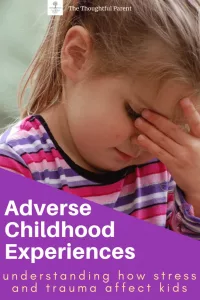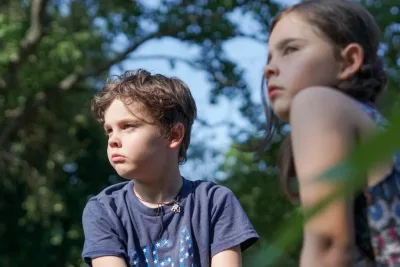The following article originally appeared on The Thoughtful Parent
To say the last 18+ months of pandemic living has been stressful for parents and children is an understatement. Parents often wonder what impact this stress (and related stressors) will have on children long-term. While research is still digging into that question, one immediate resource we have available to us is the years of research on the impact of stress in children’s lives, especially adverse childhood experiences.
Stress can take many forms and although we often have a completely negative conception of stress, not all stress is harmful for children’s development. To help us understand the different types of stressors and how they might impact children, I’m thrilled to have the opportunity to do a virtual Q and A with Genevieve Rivera, executive director of the American Society for the Positive Care of Children, a non-profit dedicated to educating parents and helping all children reach their full potential. Our discussion will hopefully help you gain insight into how stress may impact your children’s lives.
Q1. What are ACE’s?
Adverse childhood experiences (ACEs) are potentially traumatic events before the age of 18 that research has linked to negative, lasting effects.
They were introduced through the Adverse Childhood Experiences Study in the late 1990s – a large and very important public health study that discovered a staggering link between childhood toxic stress and social and emotional problems as well as chronic diseases people develop as adults.
The study linked the following 10 adverse childhood experiences to negative health impacts later in life:
- Physical, emotional or sexual abuse.
- Physical or emotional neglect.
- Household dysfunction such as mental illness, substance abuse, domestic violence, divorce, or an incarcerated relative.
The study’s researchers came up with a 10-question assessment to determine a person’s risk for chronic disease. You can think of it as a cholesterol score for childhood toxic stress — you get one point for each type of trauma. The higher your ACE score, the higher your potential risk of health and social problems.
It’s important to note the original study didn’t account for stressors outside of the home that also play a role in a child’s well-being later in life. These may include violence, poverty, racism, other forms of discrimination, isolation, a chaotic environment, lack of vital services and other forms of stress. Data has shown these types of experiences play a similarly important role in a child’s health outcomes, and researchers are beginning to include them in the overall discussion of ACEs.

Q2. Why is it important for parents to understand ACE’s?
Recognizing these negative experiences and their impacts can be a powerful tool for parents and caregivers. Not only do they help us understand how ACEs may have affected our own well-being, but they allow us to see the bigger picture stress plays on a child’s development. Not all ACEs can be avoided, but their impact can be mitigated when a parent is there to safely and consistently support them.
However, when a child experiences ACEs and there aren’t any caring adults present to buffer the effects, this can lead to toxic levels of stress, which has even greater negative effects on a child’s overall health and well-being.
Q3. How do ACE’s affect children’s long-term development?
Researchers have linked adverse childhood experiences to a wide range of poor outcomes later in life. These include lower educational achievement and economic success, impaired social skills, alcoholism, anxiety, depression, drug abuse, eating disorders, obesity, suicide, and certain chronic diseases.
This is because certain types of ACEs, especially when prolonged or when there are multiple, have been shown to cause biological reactions in a child. These stress responses are like wear and tear on a car: if you are revving the engine for days or weeks at a time, the engine will begin to suffer.
The good news is many ACEs can be mitigated and sometimes avoided, and awareness of this cause-and-effect relationship is a powerful tool for parents.
Q4. Why have more parents become interested in learning about ACE’s in recent months?
While the pandemic has kept families at home and away from their routines and loved ones, there has been a large focus on social and emotional health. Many families found it hard to ignore the impacts these big changes were having on both adults and kids in the household.
Typically, it takes years to determine the long-term effects of adverse experiences. However, preliminary data is beginning to paint a picture of how the pandemic is hurting our nation’s social, emotional and physical health, and researchers say there is a pressing need to address these concerns through a variety of tactics, including developing healthy coping mechanisms.
When considering all of this, we weren’t surprised to see a major increase in visitors to our website’s Parenting Resource Center, many of them visiting our ACEs resources. In the first six months of 2021, our Parenting Resource Center has served the same amount of people it did in all of 2020. This tells us there’s a growing interest in mental health awareness and education, and people are eager to learn how they can support themselves and others.
While it’s unfortunate that so many families are under this level of heightened pressure, our hope is that our online resources offer strategies and insights that parents can use to better support their children and build stronger bonds, even after the pandemic is over.
Q5. Can you explain the difference between ACE’s and typical stress that a child may experience in daily life?
Stress is, of course, a normal and unavoidable part of children’s lives. In fact, positive types of stress are important for healthy development and building resiliency. Stress can be broken down into three types: positive, tolerable and toxic.
When a child is asked to solve a problem, concentrate on a difficult task, meet new people or attend a first day of school, the positive stress from these events are typically short and actually help prepare the body for difficult situations later in life. It’s the body’s way of learning how to deal with increased stress hormones, which will only be heightened for a short period during these types of situations.
However, when stress becomes more intense or prolonged, more attention should be paid to potential long-term effects. Tolerable stress can include unavoidable forms of negative stress, such as the death of a loved one, moving away from home, or a natural disaster. But when a caring adult is in a child’s life to support them through these events, stress levels and long-term effects can often be kept under control.
Toxic stress stems from repeated exposure to negative experiences such as neglect, abuse or serious hardships — many of them a part of the ten adverse childhood experiences. When a child experiences toxic stress and doesn’t have a supportive adult to help buffer their responses, stress hormones can remain dangerously high. If this type of stress happens often, the negative effects are compounded. These are the types of experiences families should try to avoid or help their child through so they can mitigate health problems later in life.
However, there are times where these negative experiences cannot be avoided, such as a divorce or parental substance abuse, at which point it’s important to ensure parents are providing positive support systems during those times to help build the foundation of resilience — the skills and abilities that develop through experience and allow us to adapt and stay healthy.
Q6. How can parents determine whether the stress their child has experienced would be considered an ACE or not?
Taking a look at the ten-question ACEs quiz is a good place to start. However, the original study didn’t account for stressors outside of the home that also play a role in a child’s well-being later in life, as we talked about above. The CDC updates their list of individual, family and community risk factors, which you can check out here.
As a general rule, try to determine whether a form of stress is in the positive, tolerable or toxic category. This can help you determine a proper response. If it’s tolerable stress, try to be as supportive as possible to help your child cope. If it’s a form of toxic stress, especially when prolonged or repeated, this would be an adverse childhood experience and a parent should offer loving support while trying their best to avoid these experiences from happening again.
Q7. What can parents do to support children who may have experienced ACE’s in their life?
Being aware of adverse experiences and how they impact children’s lives is the first step towards offering support. When you have this understanding, you can relate to your child’s emotional needs and offer more targeted responses. Simply being a supportive caregiver in a child’s life can go a long way towards helping them build resilience.
For parents who want to learn more about how they can be this sort of buffer, or about positive parenting techniques in general, we suggest tapping into free research-based resources such as the Happy Child App, or visit American SPCC’s Parenting Resource Center for a variety of topics, including the Brain Story, which explains children’s neurological response to stress.
EXTRA Q: What about for neighbors, friends and caregivers? How can they support children who have experienced ACEs?
Researchers have noted that early-life adversity is a significant public health issue in our country. But if you are an adult who has a presence in a child’s life, you can play a role in mitigating the effects of these adverse experiences. Statistics show that having safe, stable, and nurturing relationships can buffer adversity and help build resilience among children and the CDC explains how communities — such as neighborhoods, counties, states or formal groups — can help build these types of relationships and environments for children.
The children in our homes, our neighborhoods and in our country will be the leaders of tomorrow. It’s important adults think carefully about the role they can and should play in building brighter futures.
Many thanks to Genevieve Rivera all the staff at American SPCC for this timely and thoughtful Q and A session. If you have further questions, feel free to contact me at: amyw@thoughtfulparent.com or see all the wonderful resources at the American SPCC website.
AMY WEBB
Writer and mom of two who brings academic child development and parenting information into the lives of ordinary parents who can use it in their daily lives.

